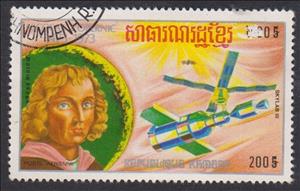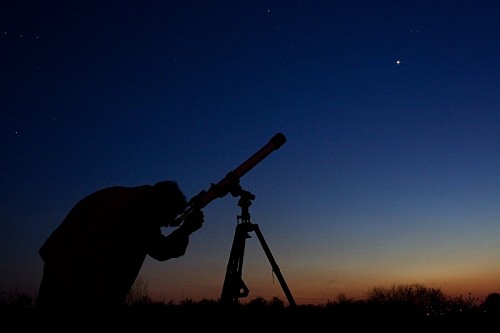Stamp: Nicolaus Copernikus and Skylab III (Cambodia 1974)
Nicolaus Copernikus and Skylab III (Cambodia 1974)
10 September (Cambodia ) within release 500th birthday of Nicolaus Copernikus goes into circulation Stamp Nicolaus Copernikus and Skylab III face value 200 Cambodian riel
| Stamp Nicolaus Copernikus and Skylab III in catalogues | |
|---|---|
| Michel: | Mi:KH 397 |
| Yvert et Tellier: | Yt:KH PA31G |
Stamp is square format.
Also in the issue 500th birthday of Nicolaus Copernikus:
- Stamp - Vaisseau Nerva face value 1;
- Stamp - Nicolaus Copernicus - Mariner II face value 5;
- Stamp - Nicolaus Copernikus-Apollo face value 10;
- Stamp - Alunnisage face value None;
- Stamp - Nicolaus Copernikus and lander face value 150;
- Stamp - Nicolaus Copernikus and Skylab III face value 200;
- Stamp - Concorde face value 250;
- Souvenir Sheet - 500th Birthday of Nicolaus Copernicus (1973)(II) Block A face value 1,200;
- Stamp - 500th Birthday of Nicolaus Copernicus (1973)(II) face value 1,200;
- Stamp - Sortie dans l'espace face value 50;
- Stamp - Copernicus, Sun face value 1,200;
- Souvenir Sheet - Copernicus, Sun face value 1,200;
- Stamp - Copernicus, Sun face value 1,200;
Stamp Nicolaus Copernikus and Skylab III it reflects the thematic directions:
An astronomer is a scientist in the field of astronomy who focuses their studies on a specific question or field outside the scope of Earth. They observe astronomical objects such as stars, planets, moons, comets and galaxies – in either observational (by analyzing the data) or theoretical astronomy. Examples of topics or fields astronomers study include planetary science, solar astronomy, the origin or evolution of stars, or the formation of galaxies. A related but distinct subject is physical cosmology, which studies the Universe as a whole
Outer space (or simply space) is the expanse that exists beyond Earth's atmosphere and between celestial bodies. It contains ultra-low levels of particle densities, constituting a near-perfect vacuum of predominantly hydrogen and helium plasma, permeated by electromagnetic radiation, cosmic rays, neutrinos, magnetic fields and dust. The baseline temperature of outer space, as set by the background radiation from the Big Bang, is 2.7 kelvins (−270 °C; −455 °F)
A satellite or artificial satellite is an object, typically a spacecraft, placed into orbit around a celestial body. They have a variety of uses, including communication relay, weather forecasting, navigation (GPS), broadcasting, scientific research, and Earth observation. Additional military uses are reconnaissance, early warning, signals intelligence and, potentially, weapon delivery. Other satellites include the final rocket stages that place satellites in orbit and formerly useful satellites that later become defunct.



